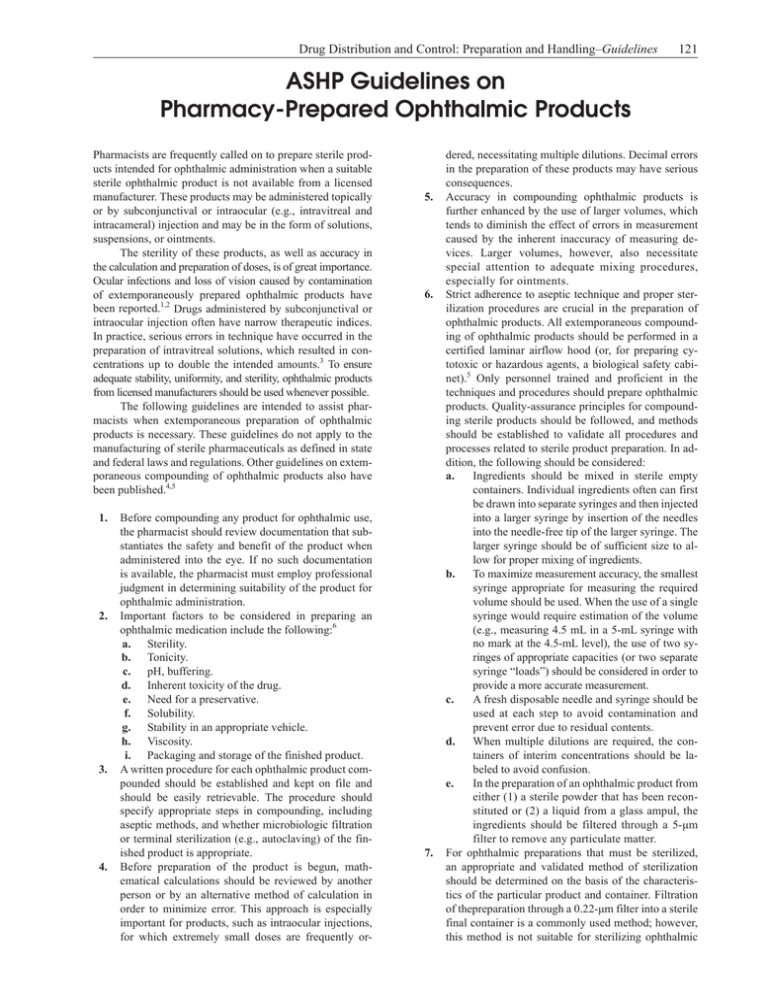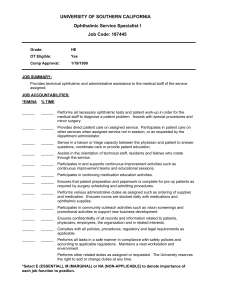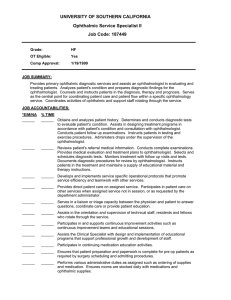
Drug Distribution and Control: Preparation and Handling–Guidelines 121
ASHP Guidelines on
Pharmacy-Prepared Ophthalmic Products
Pharmacists are frequently called on to prepare sterile products intended for ophthalmic administration when a suitable
sterile ophthalmic product is not available from a licensed
manufacturer. These products may be administered topically
or by subconjunctival or intraocular (e.g., intravitreal and
intracameral) injection and may be in the form of solutions,
suspensions, or ointments.
The sterility of these products, as well as accuracy in
the calculation and preparation of doses, is of great importance.
Ocular infections and loss of vision caused by contamination
of extemporaneously prepared ophthalmic products have
been reported.1,2 Drugs administered by subconjunctival or
intraocular injection often have narrow therapeutic indices.
In practice, serious errors in technique have occurred in the
preparation of intravitreal solutions, which resulted in concentrations up to double the intended amounts.3 To ensure
adequate stability, uniformity, and sterility, ophthalmic products
from licensed manufacturers should be used whenever possible.
The following guidelines are intended to assist pharmacists when extemporaneous preparation of ophthalmic
products is necessary. These guidelines do not apply to the
manufacturing of sterile pharmaceuticals as defined in state
and federal laws and regulations. Other guidelines on extemporaneous compounding of ophthalmic products also have
been published.4,5
1. Before compounding any product for ophthalmic use,
the pharmacist should review documentation that substantiates the safety and benefit of the product when
administered into the eye. If no such documentation
is available, the pharmacist must employ professional
judgment in determining suitability of the product for
ophthalmic administration.
2. Important factors to be considered in preparing an
ophthalmic medication include the following:6
a. Sterility.
b. Tonicity.
c. pH, buffering.
d. Inherent toxicity of the drug.
e. Need for a preservative.
f. Solubility.
g. Stability in an appropriate vehicle.
h. Viscosity.
i. Packaging and storage of the finished product.
3. A written procedure for each ophthalmic product compounded should be established and kept on file and
should be easily retrievable. The procedure should
specify appropriate steps in compounding, including
aseptic methods, and whether microbiologic filtration
or terminal sterilization (e.g., autoclaving) of the finished product is appropriate.
4. Before preparation of the product is begun, mathematical calculations should be reviewed by another
person or by an alternative method of calculation in
order to minimize error. This approach is especially
important for products, such as intraocular injections,
for which extremely small doses are frequently or-
dered, necessitating multiple dilutions. Decimal errors
in the preparation of these products may have serious
consequences.
5. Accuracy in compounding ophthalmic products is
further enhanced by the use of larger volumes, which
tends to diminish the effect of errors in measurement
caused by the inherent inaccuracy of measuring devices. Larger volumes, however, also necessitate
special attention to adequate mixing procedures,
especially for ointments.
6. Strict adherence to aseptic technique and proper sterilization procedures are crucial in the preparation of
ophthalmic products. All extemporaneous compounding of ophthalmic products should be performed in a
certified laminar airflow hood (or, for preparing cytotoxic or hazardous agents, a biological safety cabinet).5 Only personnel trained and proficient in the
techniques and procedures should prepare ophthalmic
products. Quality-assurance principles for compounding sterile products should be followed, and methods
should be established to validate all procedures and
processes related to sterile product preparation. In addition, the following should be considered:
a. Ingredients should be mixed in sterile empty
containers. Individual ingredients often can first
be drawn into separate syringes and then injected
into a larger syringe by insertion of the needles
into the needle-free tip of the larger syringe. The
larger syringe should be of sufficient size to allow for proper mixing of ingredients.
b. To maximize measurement accuracy, the smallest
syringe appropriate for measuring the required
volume should be used. When the use of a single
syringe would require estimation of the volume
(e.g., measuring 4.5 mL in a 5-mL syringe with
no mark at the 4.5-mL level), the use of two syringes of appropriate capacities (or two separate
syringe “loads”) should be considered in order to
provide a more accurate measurement.
c. A fresh disposable needle and syringe should be
used at each step to avoid contamination and
prevent error due to residual contents.
d. When multiple dilutions are required, the containers of interim concentrations should be labeled to avoid confusion.
e. In the preparation of an ophthalmic product from
either (1) a sterile powder that has been reconstituted or (2) a liquid from a glass ampul, the
ingredients should be filtered through a 5-μm
filter to remove any particulate matter.
7. For ophthalmic preparations that must be sterilized,
an appropriate and validated method of sterilization
should be determined on the basis of the characteristics of the particular product and container. Filtration
of thepreparation through a 0.22-μm filter into a sterile
final container is a commonly used method; however,
this method is not suitable for sterilizing ophthalmic
122 Drug Distribution and Control: Preparation and Handling–Guidelines
suspensions and ointments.7 When an ophthalmic
prep­aration is compounded from a nonsterile ingredient, the final product must be sterilized before it
is dispensed. Sterilization by autoclaving in the final
container may be possible, provided that product stability is not adversely affected and appropriate quality
control procedures are followed.6
8. Preservative-free ingredients should be used in the
preparation of intraocular injections, since some preservatives are known to be toxic to many of the internal
structures of the eye.6
9. In the preparation of ophthalmic products from cytotoxic or other hazardous agents, the pharmacist should
adhere to established safety guidelines for handling such
agents.8,9
1 0. The final container should be appropriate for the
ophthalmic product and its intended use and should
not interfere with the stability and efficacy of the preparation.10 Many ophthalmic liquids can be packaged in
sterile plastic bottles with self-contained dropper tips
or in glass bottles with separate droppers. Ophthalmic
ointments should be packaged in sterilized ophthalmic
tubes. Injectables that are not for immediate use should
be packaged in sterile vials rather than in syringes, and
appropriate overfill should be included. All containers
should be adequately sealed to prevent contamination.
11. The pharmacist should assign appropriate expiration dates to extemporaneously prepared ophthalmic
products; these dates should be based on documented
stability data as well as the potential for microbial contamination of the product.11 The chemical stability of
the active ingredient, the preservative, and packaging
material should be considered in determining the overall stability of the final ophthalmic product.12
1 2. Ophthalmic products should be clearly and accurately
labeled. In some cases, it may be appropriate to label
the products with both the weight and concentration
of active ingredients and preservatives. Labels should
also specify storage and handling requirements and
expiration dates. Extemporaneously prepared ophthalmic products dispensed for outpatient use should be
labeled in accordance with applicable state regulations
for prescription labeling.
References
1.Associated Press. Pittsburgh woman loses eye to
tainted drugs; 12 hurt. Baltimore Sun. 1990; Nov 9:3A.
2. Associated Press. Eye drop injuries prompt an FDA
warning. N Y Times. 1990; 140(Dec 9):39I.
3. Jeglum EL, Rosenberg SB, Benson WE. Preparation
of intravitreal drug doses. Ophthalmic Surg.
1981; 12:355–9.
4. Reynolds LA. Guidelines for preparation of sterile
ophthalmic products. Am J Hosp Pharm. 1991;
48:2438–9.
5. Reynolds LA, Closson R. Ophthalmic drug formulations. A handbook of extemporaneous products.
Vancouver, WA: Applied Therapeutics; (in press).
6.The United States Pharmacopeia, 22nd rev., and
The National Formulary, 17th ed. Rockville, MD:
The
United States Pharmacopeial Convention;
1989:1692–3.
7. Allen LV. Indomethacin 1% ophthalmic suspension.
US Pharm. 1991; 16(May):82–3.
8.American Society of Hospital Pharmacists. ASHP
technical assistance bulletin on handling cytotoxic and
hazardous drugs. Am J Hosp Pharm. 1990; 47:1033–49.
9. OSHA work-practice guidelines for personnel dealing with cytotoxic (antineoplastic) drugs. Am J Hosp
Pharm. 1986; 43:1193–204.
10.Ansel HC, Popovich NG. Pharmaceutical dosage
forms and drug delivery systems. 5th ed. Philadelphia:
Lea & Febiger; 1990:354–7.
11. Stolar MH. Expiration dates of repackaged drug products. Am J Hosp Pharm. 1979; 36:170. Editorial.
12. Remington’s pharmaceutical sciences. 19th ed. Gennaro
AR, ed. Easton, PA: Mack Publishing; 1990:1581–
959.
These guidelines were reviewed in 2008 by the Council on Pharmacy
Practice and by the Board of Directors and were found to still be appropriate.
Approved by the ASHP Board of Directors, April 21, 1993.
Developed by the ASHP Council on Professional Affairs.
Copyright © 1993, American Society of Hospital Pharmacists, Inc.
All rights reserved.
The bibliographic citation for this document is as follows: American
Society of Hospital Pharmacists. ASHP technical assistance bulletin on pharmacy-prepared ophthalmic products. Am J Hosp Pharm.
1993; 50:1462–3.




